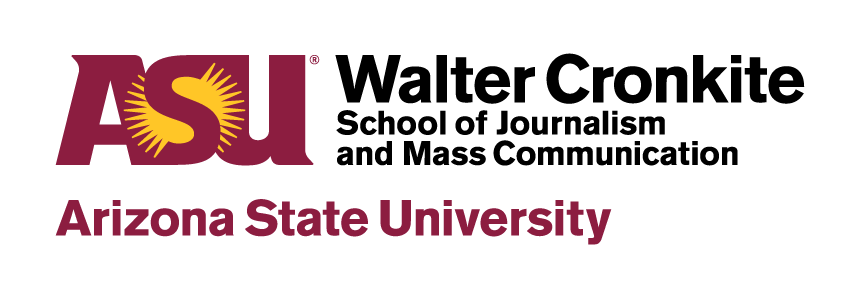By Jordan Gerard
Political debates expand access to Deaf community
Minutes before the political debate is scheduled to begin, it’s pandemonium in the television studio.
Bright studio lights illuminate every inch of the space but do little to warm up the room, which is edged by a black curtain.
Laminated badges swing from pressed business outfits, lanyards tangle with necklaces, and big, black headsets ride in and out of the room as someone shouts. “over here,” down a hallway. A black Labrador sniffs out corridors, the control room, the green room.
In a corner, tucked away from the chaos, Linda Bove and Ernest Willman are preparing to interpret an Oct. 6 debate between Arizona candidates for the U.S. Senate hosted by Arizona PBS.
It will take the two of them, plus two more, to get the job done. Certified Hearing Interpreters Cameo Hunsaker and LaDonna Gabrielson will listen to the speakers and feed their messages to Bove and Willman, who will add emotion and tone to the interpretations.
It’s a difficult job, especially during a political debate, which can be a sort of verbal ping-pong match, filled with emotion and nuance. But it’s also an essential job for more than 1 million Arizonans – nearly 17% of the population – who are hard of hearing.
Despite its size, the Deaf community is often excluded from politics, Willman said in a post-debate interview.
“Their input is not included because they don’t have access to information,” he said. “There are two different cultures and languages at play.” Providing interpretation means “the entire community in Arizona is able to get that information.”
A debate in detail
Promptly at 6 p.m., Arizona PBS moderator Ted Simons opened the debate: “Our debate rules tonight are that each candidate will get 90 seconds to answer a question with 45 seconds for rebuttal periods,” he said.
Bove and Hunsaker were assigned to Simons and incumbent Democratic Sen. Mark Kelly. They agreed on a set of role-shifting techniques that consist of leaning in a predetermined direction for one person and the opposite direction for another. So when Hunsaker leaned to the right, it meant Kelly was speaking. When she leaned to the left, Simons was asking a question.
They also identified speakers by signing something along the lines of “This is the moderator speaking,” or “The Democratic candidate is speaking,” Hunsaker said. Then Bove, the deaf interpreter, would translate what was being said into American Sign Language.
In addition to relaying words, interpreters try to capture tone and emotion and provide context, explaining, for example, implied information or cultural references. While they do all of that, they’re also trying to take in the next thing that’s being said.
Hunsaker said she can interpret as fast as someone is speaking – but during a debate, she’s about three to eight seconds behind the person speaking.
When people interrupt or talk over each other, it’s especially hard to identify clearly who is saying what, she said.
“… if we can’t collect taxes from the wealthiest Americans and the largest corporations, they’re cheating on their taxes, you know who pays?” Kelly said. “Middle class Americans pay.”
“He said it himself. He wants 87,000 IRS–” Masters interrupted.
“Hold on–” Kelly tried.
“Just a second–” Simons interjected.
“He–”
“Just a second–”
“You’re going to get a second. So relax,” Kelly responded, raising his left hand in Master’s direction and lowering it emphatically.
To prepare for the Senate debate, Willman said the interpreters observed how the candidates previously communicated with each other, what their one-on-one interaction was like and how they interacted with the media.
Two weeks beforehand, the team took a tour of the PBS studio on ASU’s downtown Phoenix campus, where they met the TV crew and ran through a few mock scenarios.
“I enjoyed having an opportunity to work with a partner, studio crew,” he said, “providing the top-quality service as it relates to lighting, clothing options, the makeup, backgrounds and how everything was set up, where the seating was located. [The crew] making sure interpreters were comfortable, and at the same time providing and delivering that message as well.”
Caption this, accurately
More media companies seem to be choosing automated captioning, Willman said, and while he’s grateful for that, captions don’t communicate emotions or tones.
“Hearing people are able to capture those things,” he said. “The Deaf community is left out of that access with the debate.”
An advanced level of interpretation allows language, emotion, feelings, how fast or slow the speech is or if the speaker is more direct or makes a softer point, he said.
Whether it’s a rapid political debate or a slow-paced documentary, captions often do not provide full access for deaf individuals whose primary language is ASL, Willman added. Captions are often garbled, confusing and riddled with errors, like mixing up the words “deaf” and “death.”
Willman explained the difference between access and accessibility versus accommodations. He said accessibility guarantees people will have access to the information, but accommodations are asked for and not guaranteed.
If only closed captioning is provided, the decision is made for the deaf person that the only way they can have access is through written English, Gabrielson said.
“It does not provide equal access for the deaf viewer who knows sign language,” she said.
Learning ASL
Willman was born deaf into a family. His parents and siblings are all deaf. His mother attended a hearing school, where she was not allowed to sign in class. If she did, she would be disciplined, he said.
His father attended a deaf school but did not graduate from high school.
Willman himself attended a school for the deaf. When he brought papers home, he would explain them to his mother in ASL.
He began thinking about becoming an interpreter when watching his parents interpret for international students at his school, and later, at college events.
Hunsaker learned ASL in college while studying theater. In an advanced sign language class at the University of Pittsburgh, her Deaf teacher pulled her aside and told her she would make a great interpreter. She moved west chasing that dream.
“I’m constantly learning, still, after 20 years,” Hunsaker said. “I really just fell in love with the language and wanted to be involved with the Deaf community in any way I could. Interpreting seemed like the path for that to happen.”
There’s no written form of ASL, so interpreters vary in how they approach the language, she said. Each has their own “accent.”
Hunsaker is a staunch believer that providing interpreters for political debates and news updates, such as those held during the pandemic, is critical.
“I believe interpreters should be included in all news reports every day. Lots of other countries provide that service,” she said. “Here in the U.S., there has been considerable push-back for having interpreters on television screens because most people erroneously believe that captions are enough.”
She and Gabrielson point out that many people who use ASL consider ASL their first language and English their second language. In an email, Gabrielson put it this way: “People who are deaf and those who use sign language to communicate deserve to have access to the debate in their first language.”

